Exploring the Nonlinear Impacts of Built Environment on Urban Vitality from a Spatiotemporal Perspective at the Block Scale in Chongqing
Abstract
1. Introduction
2. Literature Review
2.1. Urban Vitality and Measurement Methods
2.2. Relationship Between Built Environment and Urban Vitality
2.3. Methods for Analyzing Built Environment and Urban Vitality
3. Materials and Methods
3.1. Study Area
3.2. Data
3.2.1. Urban Vitality
3.2.2. Built Environment
3.3. Methods
4. Results
4.1. Spatiotemporal Patterns of Urban Vitality
4.2. Relative Importance of Built Environment
4.3. Nonlinear Impacts of Built Environment on Urban Vitality
4.3.1. Nonlinear Impacts of Density on Urban Vitality
4.3.2. Nonlinear Impacts of Diversity on Urban Vitality
4.3.3. Nonlinear Impacts of Design on Urban Vitality
4.3.4. Nonlinear Impacts of Destination Accessibility on Urban Vitality
4.3.5. Nonlinear Impacts of Distance to Transition on Urban Vitality
4.4. The Interactive Impacts of Built Environment on Urban Vitality
5. Discussion
5.1. Advantages of the Methodology
5.2. Impacts of Single Indicators on Urban Vitality
5.2.1. Spatial Impacts of Built Environment Indicators on Urban Vitality
5.2.2. Temporal Impacts of Built Environment Indicators on Urban Vitality
5.3. Interaction Effects of Indicators on Urban Vitality
5.4. Limitations and Future Research
6. Conclusions
- (1)
- In terms of the spatiotemporal distribution of urban vitality in the central urban area of Chongqing, there are significant differences in urban vitality distribution between the inner and outer ring road areas. The inner ring area shows high and concentrated urban vitality, mainly around commercial and transportation hubs such as Jiefangbei and Guanyin Bridge. In contrast, the outer ring has lower vitality but features several secondary vitality clusters, reflecting a “multi-center, cluster-type” spatial structure. Temporally, urban vitality is higher in the evening on weekdays, stronger in the afternoon on weekends, and generally lower on holidays. Notably, urban vitality is particularly low in the morning on holidays, gradually increasing in the afternoon and evening.
- (2)
- The influence of the built environment’s dimension on urban vitality is ranked in the following order: diversity, design, destination accessibility, density, and distance to transition. The built environment has a stronger overall impact on urban vitality during holidays, with the evening period on holidays having a higher impact than other periods. Specifically, RID has the greatest impact on urban vitality on weekdays and holidays, BD has the greatest impact on the morning of weekends, CLA has the greatest impact on the afternoon of weekends, and CA has the most significant impact on the evening of weekends.
- (3)
- The impacts of the built environment on urban vitality exhibit significant nonlinear characteristics, with BD and PSA showing a first increasing and then inhibiting effect on urban vitality; lower CA, CLA, and MSA have inhibitory effects on urban vitality, with higher NDVI values similarly demonstrating such effects; BH, BSD, RD, and RID have enhancing effects on urban vitality; FMD shows an increase, followed by suppression, and then an increase again in the morning and afternoon on weekdays and in the morning on holidays. In other time periods, it shows an enhancing impact. WPI first shows an inhibiting and then increasing effect on urban vitality in the afternoon on weekends and in the morning on holidays. In other time periods, WPI shows an increase, followed by suppression, and then an increase again.
- (4)
- There are significant interactive effects among BE indicators such as BD and BH, CA; RD and WPI, MSA; FMD and BH, PSA; PSA and CLA. Considering these interactive relationships comprehensively is of great significance for optimizing BE and enhancing urban vitality.
Author Contributions
Funding
Data Availability Statement
Conflicts of Interest
Abbreviations
| BE | Built environment |
| UV | Urban vitality |
| BD | Building density |
| RD | Road network density |
| FMD | Functional mix degree |
| WPI | Water proximity index |
| NDVI | Normalized difference vegetation index |
| RID | Road intersection density |
| BH | Building height |
| CA | Commercial accessibility |
| CLA | Cultural and leisure accessibility |
| PSA | Park and square accessibility |
| BSD | Bus stop density |
| MSA | Metro station accessibility |
References
- Sung, H.; Lee, S.; Cheon, S. Operationalizing Jane Jacobs’s Urban Design Theory: Empirical Verification from the Great City of Seoul, Republic of Korea. J. Plan. Educ. Res. 2015, 35, 117–130. [Google Scholar] [CrossRef]
- Lopes, M.N.; Camanho, A.S. Public Green Space Use and Consequences on Urban Vitality: An Assessment of European Cities. Soc. Indic. Res. 2013, 113, 751–767. [Google Scholar] [CrossRef]
- Tang, L.; Lin, Y.; Li, S.; Li, S.; Li, J.; Ren, F.; Wu, C. Exploring the Influence of Urban Form on Urban Vibrancy in Shenzhen Based on Mobile Phone Data. Sustainability 2018, 10, 4565. [Google Scholar] [CrossRef]
- Sulis, P.; Manley, E.; Zhong, C.; Batty, M. Using mobility data as proxy for measuring urban vitality. J. Spat. Inf. Sci. 2018, 16, 137–162. [Google Scholar] [CrossRef]
- Li, M.; Liu, J.; Lin, Y.; Xiao, L.; Zhou, J. Revitalizing historic districts: Identifying built environment predictors for street vibrancy based on urban sensor data. Cities 2021, 117, 103305. [Google Scholar] [CrossRef]
- Tang, S.; Ta, N. How the built environment affects the spatiotemporal pattern of urban vitality: A comparison among different urban functional areas. Comput. Urban Sci. 2022, 2, 39. [Google Scholar] [CrossRef]
- Kang, C.D. Effects of the human and built environment on neighborhood vitality: Evidence from Seoul, Korea, using mobile phone data. J. Urban Plan. Dev. 2020, 146, 05020024. [Google Scholar] [CrossRef]
- Jacobs, J. The Death and Life of Great American Cities; Random House: New York, NY, USA, 1961. [Google Scholar]
- Lynch, K. A Theory of Good City Form; MIT Press: Cambridge, MA, USA, 1981. [Google Scholar]
- Montgomery, J. Making a city: Urbanity, vitality and urban design. J. Urban Des. 1998, 3, 93–116. [Google Scholar] [CrossRef]
- Balram, S.; Dragićević, S. Attitudes toward urban green spaces: Integrating questionnaire survey and collaborative GIS techniques to improve attitude measurements. Landsc. Urban Plan. 2005, 71, 147–162. [Google Scholar] [CrossRef]
- Sheng, J.; He, Y.; Lu, T.; Wang, F.; Huang, Y.; Leng, B.; Chen, Y. Unveiling urban vitality and its interactions in mountainous cities: A human behaviour perspective on community-level dynamics. Cities 2025, 159, 105780. [Google Scholar] [CrossRef]
- Li, J.; Li, J.; Yuan, Y. Spatiotemporal distribution characteristics and mechanism analysis of urban population density: A case of Xi’an, Shaanxi, China. Cities 2019, 86, 62–70. [Google Scholar] [CrossRef]
- Zheng, Q.; Deng, J.; Jiang, R.; Wang, K.; Xue, X.; Lin, Y.; Huang, Z.; Shen, Z.; Li, J.; Shahtahmassebi, A.R. Monitoring and assessing “ghost cities” in Northeast China from the view of nighttime light remote sensing data. Habitat Int. 2017, 70, 34–42. [Google Scholar] [CrossRef]
- Zhang, J. Nighttime Vitality and Its Relationship to Urban Diversity: An Exploratory Analysis in Shenzhen, China. IEEE J. Sel. Top. Appl. Earth Obs. Remote Sens. 2022, 15, 309–322. [Google Scholar] [CrossRef]
- Weishan, C.; Lin, L.; Yutian, L. Retail center recognition and spatial aggregating feature analysis of retail formats in Guangzhou based on POI data. Geogr. Res. 2016, 35, 703–716. [Google Scholar]
- Yue, Y.; Zhuang, Y.; Yeh, A.G.O.; Xie, J.Y.; Ma, C.L.; Li, Q.Q. Measurements of POI-based mixed use and their relationships with neighbourhood vibrancy. Int. J. Geogr. Inf. Sci. 2017, 31, 658–675. [Google Scholar] [CrossRef]
- Lu, S.; Shi, C.; Yang, X. Impacts of Built Environment on Urban Vitality: Regression Analyses of Beijing and Chengdu, China. Int. J. Environ. Res. Public Health 2019, 16, 4592. [Google Scholar] [CrossRef]
- Wu, C.; Ye, X.; Ren, F.; Du, Q. Check-in behaviour and spatio-temporal vibrancy: An exploratory analysis in Shenzhen, China. Cities 2018, 77, 104–116. [Google Scholar] [CrossRef]
- Li, Z.; Zhao, G. Revealing the spatio-temporal heterogeneity of the association between the built environment and urban vitality in Shenzhen. ISPRS Int. J. Geo-Inf. 2023, 12, 433. [Google Scholar] [CrossRef]
- Calabrese, F.; Diao, M.; Di Lorenzo, G.; Ferreira, J.; Ratti, C. Understanding individual mobility patterns from urban sensing data: A mobile phone trace example. Transp. Res. Part C Emerg. Technol. 2013, 26, 301–313. [Google Scholar] [CrossRef]
- Lyu, G.; Angkawisittpan, N.; Fu, X.; Sonasang, S. Enhancing urban vitality through big data: A case study of Yinchuan City using GWR and GBDT models. Sci. Rep. 2023, 15, 579. [Google Scholar]
- Wu, Y.; Xie, C.; Zhang, A.; Zhao, T.; Cao, J. Spatiotemporal analysis of urban vitality and its drivers from a human mobility perspective. ISPRS Int. J. Geo-Inf. 2025, 14, 167. [Google Scholar]
- Chen, Y.; Yu, B.; Shu, B.; Yang, L.; Wang, R. Exploring the spatiotemporal patterns and correlates of urban vitality: Temporal and spatial heterogeneity. Sustain. Cities Soc. 2023, 91, 104440. [Google Scholar] [CrossRef]
- Wu, C.; Ye, Y.; Gao, F.; Ye, X. Using street view images to examine the association between human perceptions of locale and urban vitality in Shenzhen, China. Sustain. Cities Soc. 2023, 88, 104291. [Google Scholar] [CrossRef]
- Duan, J.; Wang, H.; Liu, L.; Zhang, J. The attraction gradient of urban functions: How does functional mix at multiple scales predict urban vitality. Cities 2025, 156, 105516. [Google Scholar] [CrossRef]
- Lin, J.; Zhuang, Y.; Zhao, Y.; Li, H.; He, X.; Lu, S. Measuring the non-linear relationship between three-dimensional built environment and urban vitality based on a random forest model. Int. J. Environ. Res. Public Health 2023, 20, 734. [Google Scholar] [CrossRef]
- Cervero, R.; Kockelman, K. Travel demand and the 3Ds: Density, diversity, and design. Transp. Res. Part D Transp. Environ. 1997, 2, 265–294. [Google Scholar] [CrossRef]
- Ewing, R.; Cervero, R. Travel and the built environment: A meta-analysis. J. Am. Plan. Assoc. 2010, 76, 265–294. [Google Scholar] [CrossRef]
- Wu, W.; Ma, Z.; Guo, J.; Niu, X.; Zhao, K. Evaluating the effects of built environment on street vitality at the city level: An empirical research based on spatial panel durbin model. Int. J. Environ. Res. Public Health 2022, 19, 1664. [Google Scholar] [CrossRef]
- Chen, L.; Zhao, L.; Xiao, Y.; Lu, Y. Investigating the spatiotemporal pattern between the built environment and urban vibrancy using big data in Shenzhen, China. Comput. Environ. Urban. Syst. 2022, 95, 101827. [Google Scholar] [CrossRef]
- Xia, C.; Yeh, A.G.O.; Zhang, A. Analyzing spatial relationships between urban land use intensity and urban vitality at street block level: A case study of five Chinese megacities. Landsc. Urban Plan. 2020, 193, 103669. [Google Scholar] [CrossRef]
- Chen, S.; Lang, W.; Li, X. Evaluating urban vitality based on geospatial big data in Xiamen Island, China. Sage Open 2022, 12, 21582440221134519. [Google Scholar] [CrossRef]
- Wan, J.; Xie, Q.; Fan, X. The impact of transportation and information infrastructure on urban productivity: Evidence from 256 cities in China. Struct. Change Econ. Dyn. 2024, 68, 384–392. [Google Scholar] [CrossRef]
- Fuentes, L.; Miralles-Guasch, C.; Truffello, R.; Delclòs-Alió, X.; Flores, M.; Rodríguez, S. Santiago de Chile through the eyes of Jane Jacobs: Analysis of the conditions for urban vitality in a Latin American metropolis. Land 2020, 9, 498. [Google Scholar] [CrossRef]
- Zumelzu, A.; Barrientos-Trinanes, M. Analysis of the effects of urban form on neighborhood vitality: Five cases in Valdivia, Southern Chile. J. Hous. Built Environ. 2019, 34, 897–925. [Google Scholar] [CrossRef]
- Sallis, F.J.; Cerin, E.; Conway, L.T.; Adams, A.M.; Frank, D.L.; Pratt, M. Physical activity in relation to urban environments in 14 cities worldwide: A cross-sectional study. Lancet 2016, 387, 2207–2217. [Google Scholar] [CrossRef]
- Huang, B.; Zhou, Y.; Li, Z.; Song, Y.; Cai, J.; Tu, W. Evaluating and characterizing urban vibrancy using spatial big data: Shanghai as a case study. Environ. Plan. B Urban Anal. City Sci. 2020, 47, 1543–1559. [Google Scholar] [CrossRef]
- Lv, G.; Zheng, S.; Hu, W. Exploring the relationship between the built environment and block vitality based on multi-source big data: An analysis in Shenzhen, China. Geomat. Nat. Hazards Risk 2022, 13, 1593–1613. [Google Scholar] [CrossRef]
- Huang, J.; Hu, X.; Wang, J.; Lu, A. How diversity and accessibility affect street vitality in historic districts? Land 2023, 12, 219. [Google Scholar] [CrossRef]
- Huang, B.; Wu, B.; Barry, M. Geographically and temporally weighted regression for modeling spatio-temporal variation in house prices. Int. J. Geogr. Inf. Sci. 2010, 24, 383–401. [Google Scholar] [CrossRef]
- Yang, J.; Cao, J.; Zhou, Y. Elaborating non-linear associations and synergies of subway access and land uses with urban vitality in Shenzhen. Transp. Res. Part A Policy Pract. 2021, 144, 74–88. [Google Scholar] [CrossRef]
- Ding, C.; Cao, X.J.; Næss, P. Applying gradient boosting decision trees to examine non-linear effects of the built environment on driving distance in Oslo. Transp. Res. Part A Policy Pract. 2018, 110, 107–117. [Google Scholar] [CrossRef]
- Yang, L.; Ao, Y.; Ke, J.; Lu, Y.; Liang, Y. To walk or not to walk? Examining non-linear effects of streetscape greenery on walking propensity of older adults. J. Transp. Geogr. 2021, 94, 103099. [Google Scholar] [CrossRef]
- Song, Y.; Zhang, S.; Deng, W. Nonlinear hierarchical effects of housing prices and built environment based on multiscale life Circle-A case study of Chengdu. ISPRS Int. J. Geo-Inf. 2023, 12, 371. [Google Scholar] [CrossRef]
- Liu, D.; Lu, Y.; Yang, L. Exploring non-linear effects of environmental factors on the volume of pedestrians of different ages using street view images and computer vision technology. Travel Behav. Soc. 2024, 36, 100814. [Google Scholar] [CrossRef]
- Zhang, Y.; Haghani, A. A gradient boosting method to improve travel time prediction. Transp. Res. Part C Emerg. Technol. 2015, 58, 308–324. [Google Scholar] [CrossRef]
- Ling, Z.; Zheng, X.; Chen, Y.; Qian, Q.; Zheng, Z.; Meng, X.; Shi, X. The nonlinear relationship and synergistic effects between built environment and urban vitality at the neighborhood scale: A case study of Guangzhou’s central urban area. Remote Sens. 2024, 16, 2826. [Google Scholar] [CrossRef]
- Gao, F.; Deng, X.; Liao, S.; Liu, Y.; Li, H.; Li, G.; Chen, W. Portraying business district vibrancy with mobile phone data and optimal parameters-based geographical detector model. Sustain. Cities Soc. 2023, 96, 104635. [Google Scholar] [CrossRef]
- Yang, W. The nonlinear effects of multi-scale built environments on CO2 emissions from commuting. Transp. Res. Part D Transp. Environ. 2023, 118, 103736. [Google Scholar] [CrossRef]
- Zhao, L.; Zhang, M.; Cheng, S.; Fang, Y.; Wang, S.; Zhou, C. Investigate the effects of urban land use on PM2.5 concentration: An application of deep learning simulation. Build. Environ. 2023, 242, 110521. [Google Scholar] [CrossRef]
- Ma, J.; Cheng, J.C.; Jiang, F.; Chen, W.; Zhang, J. Analyzing driving factors of land values in urban scale based on big data and non-linear machine learning techniques. Land Use Policy 2020, 94, 104537. [Google Scholar] [CrossRef]
- Zhang, Z.; Liu, J.; Wang, C.; Zhao, Y.; Zhao, X.; Li, P.; Sha, D. A spatial projection pursuit model for identifying comprehensive urban vitality on blocks using multisource geospatial data. Sustain. Cities Soc. 2024, 100, 104998. [Google Scholar] [CrossRef]
- Liu, J.; Wang, B.; Xiao, L. Non-linear associations between built environment and active travel for working and shopping: An extreme gradient boosting approach. J. Transp. Geogr. 2021, 92, 103034. [Google Scholar] [CrossRef]
- Ding, H.; Zhao, Z.; Wang, S.; Zhang, Y.; Zheng, X.; Lu, X. Quantifying the impact of built environment on traffic congestion: A nonlinear analysis and optimization strategy for sustainable urban planning. Sustain. Cities Soc. 2025, 122, 106249. [Google Scholar] [CrossRef]
- Yu, H.; Yang, J.; Li, T.; Jin, Y.; Sun, D. Morphological and functional polycentric structure assessment of megacity: An integrated approach with spatial distribution and interaction. Sustain. Cities Soc. 2022, 80, 103800. [Google Scholar] [CrossRef]
- Wu, W.; Niu, X. Influence of built environment on urban vitality: Case study of Shanghai using mobile phone location data. J. Urban Plan. Dev. 2019, 145, 04019007. [Google Scholar] [CrossRef]
- Xie, Y.; Shang, C.; Deng, X. Evolution of urban vitality drivers from 2014 to 2022: A case study of Kunming, China. Int. J. Environ. Sci. Technol. 2025, 1–14. [Google Scholar] [CrossRef]
- Yu, H.; Yang, J.; Sun, D.; Li, T.; Liu, Y. Spatial Responses of Ecosystem Service Value during the Development of Urban Agglomerations. Land 2022, 11, 165. [Google Scholar] [CrossRef]
- Zhang, Z.; Zhao, L.; Zhang, M. Exploring non-linear urban vibrancy dynamics in emerging new towns: A case study of the Wuhan metropolitan area. Sustain. Cities Soc. 2024, 112, 105580. [Google Scholar] [CrossRef]
- Tao, T.; Cao, J. Exploring nonlinear and collective influences of regional and local built environment characteristics on travel distances by mode. J. Transp. Geogr. 2023, 109, 103599. [Google Scholar] [CrossRef]
- Huang, X.; Jiang, P.; Li, M.; Zhao, X. Applicable Framework for Evaluating Urban Vitality with Multiple-Source Data: Empirical Research of the Pearl River Delta Urban Agglomeration Using BPNN. Land 2022, 11, 1901. [Google Scholar] [CrossRef]
- Xia, X.; Zhang, Y.; Zhang, Y.; Rao, T. The spatial pattern and influence mechanism of urban vitality: A case study of Changsha, China. Front. Environ. Sci. 2022, 10, 942577. [Google Scholar] [CrossRef]
- Zhao, K.; Guo, J.; Ma, Z.; Wu, W. Exploring the spatiotemporal heterogeneity and stationarity in the relationship between street vitality and built environment. Sage Open 2023, 13, 21582440231152226. [Google Scholar] [CrossRef]
- Jin, A.; Ge, Y.; Zhang, S. Spatial Characteristics of Multidimensional Urban Vitality and Its Impact Mechanisms by the Built Environment. Land 2024, 13, 991. [Google Scholar] [CrossRef]
- Yang, L.; Wu, M.; Chen, Y.; Wu, C. Examining the impact of the urban transportation system on tangible and intangible vitality at the city-block scale in Nanjing, China. Environ. Plan. B Urban Anal. City Sci. 2024, 51, 1833–1853. [Google Scholar] [CrossRef]
- Zhang, S.; Lu, J.; Guo, R.; Yang, Y. Exploring the Relationship Between Visual Perception of the Urban Riverfront Core Landscape Area and the Vitality of Riverfront Road: A Case Study of Guangzhou. Land 2024, 13, 2142. [Google Scholar] [CrossRef]
- Li, H.; Xie, H. Noise exposure of the residential areas close to urban expressways in a high-rise mountainous city. Environ. Plan. B Urban Anal. City Sci. 2021, 48, 1414–1429. [Google Scholar] [CrossRef]
- Dong, J.; Guo, R.A.; Guo, F.; Guo, X.M.; Zhang, Z. Pocket parks–a systematic literature review. Environ. Res. Lett. 2023, 18, 167. [Google Scholar] [CrossRef]
- Fan, Z.; Duan, J.; Luo, M.; Zhan, H.; Liu, M.; Peng, W. How did built environment affect urban vitality in urban waterfronts? A case study in Nanjing reach of Yangtze River. ISPRS Int. J. Geo-Inf. 2021, 10, 611. [Google Scholar] [CrossRef]
- Zhang, Y.; Wang, X.; Wang, L.; Li, G.; Zhang, Y.; Ye, Y.; Song, J. Measurement and optimization of sustainable urban form elements in New Urban districts using multi-source data. Front. Environ. Sci. 2024, 12, 1451903. [Google Scholar] [CrossRef]
- Jalaladdini, S.; Oktay, D. Urban public spaces and vitality: A socio-spatial analysis in the streets of Cypriot towns. Procedia Soc. Behav. Sci. 2012, 35, 664–674. [Google Scholar] [CrossRef]
- Mouratidis, K.; Poortinga, W. Built environment, urban vitality and social cohesion: Do vibrant neighborhoods foster strong communities? Landsc. Urban Plan. 2020, 204, 103951. [Google Scholar] [CrossRef]
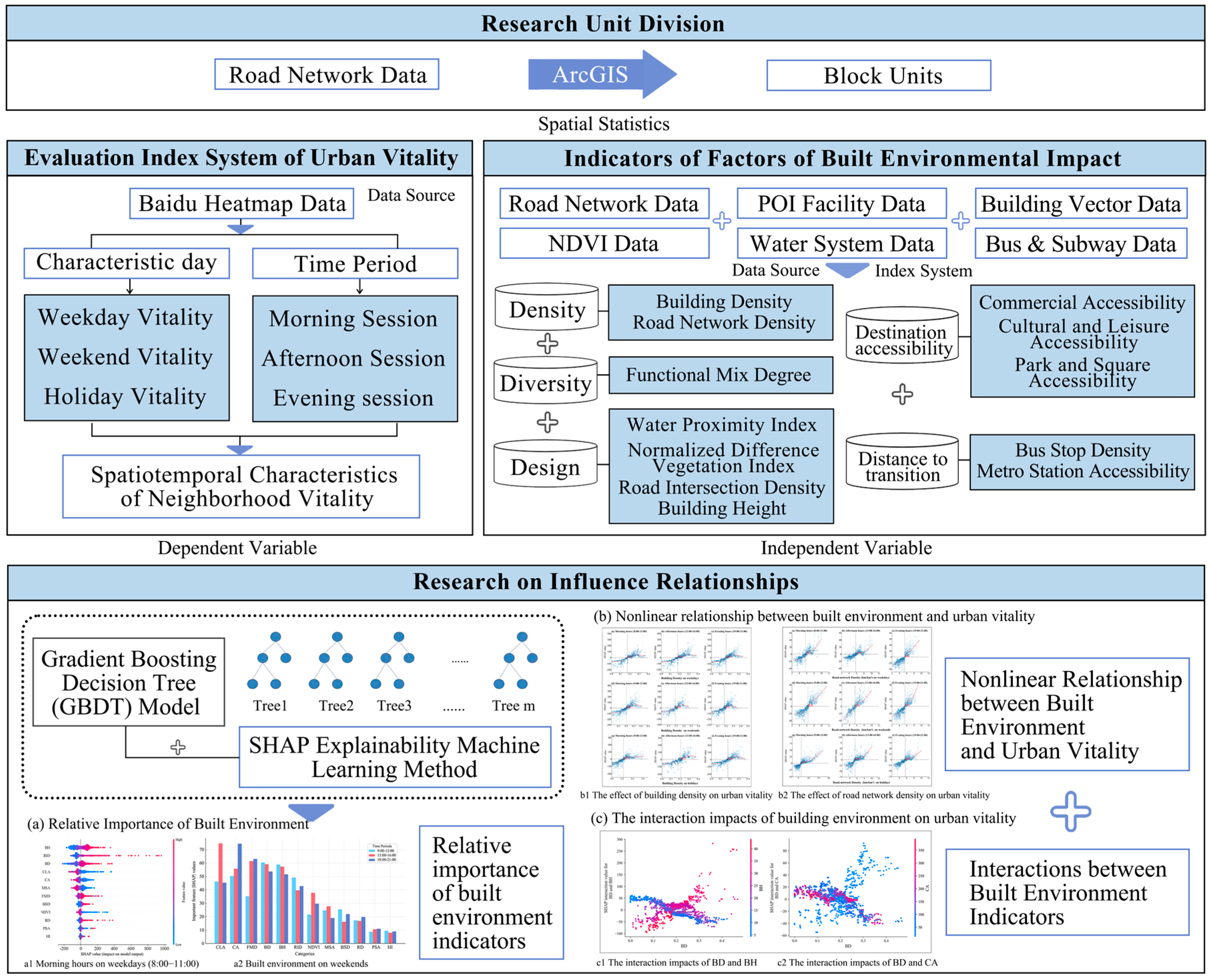
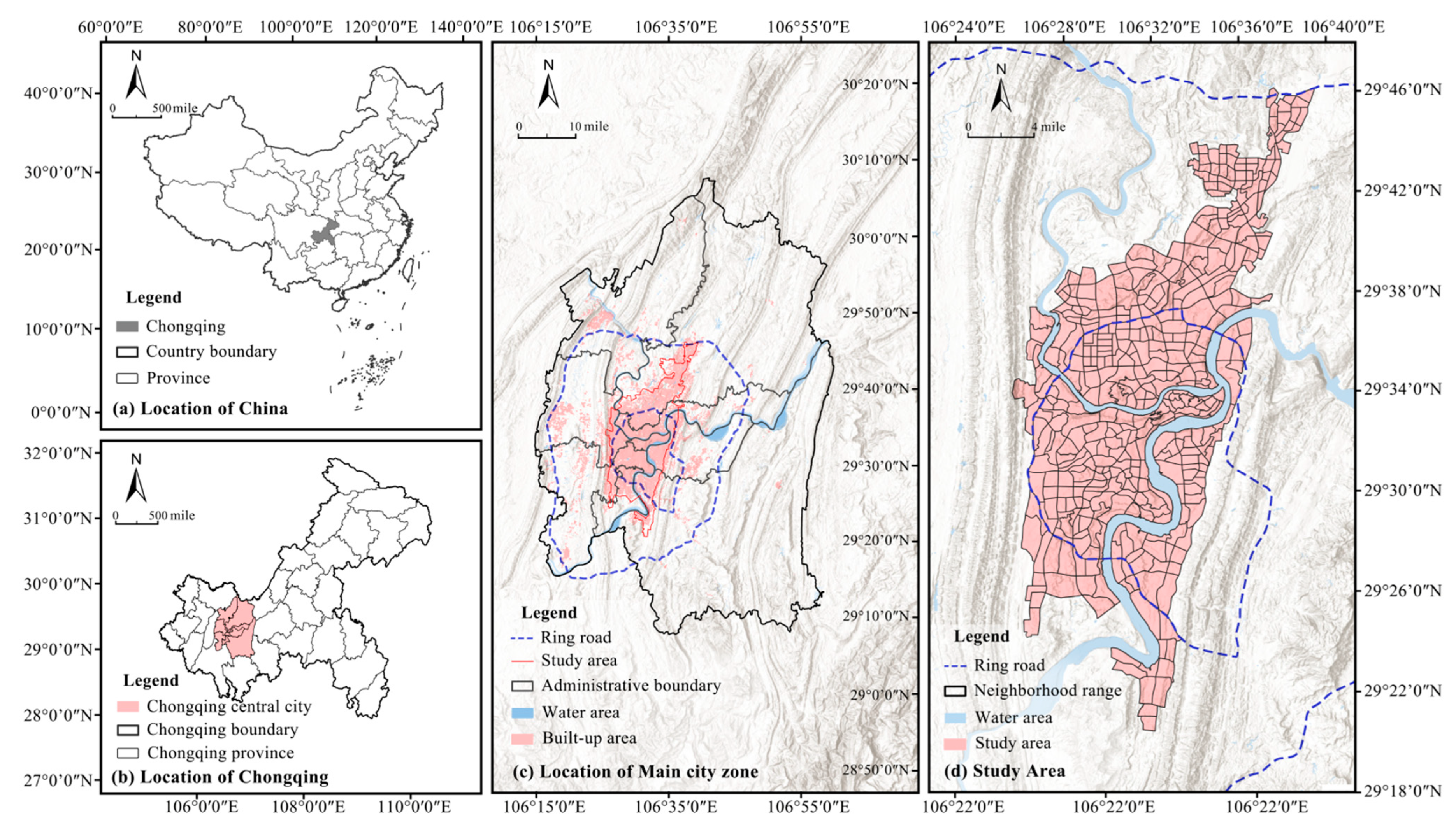
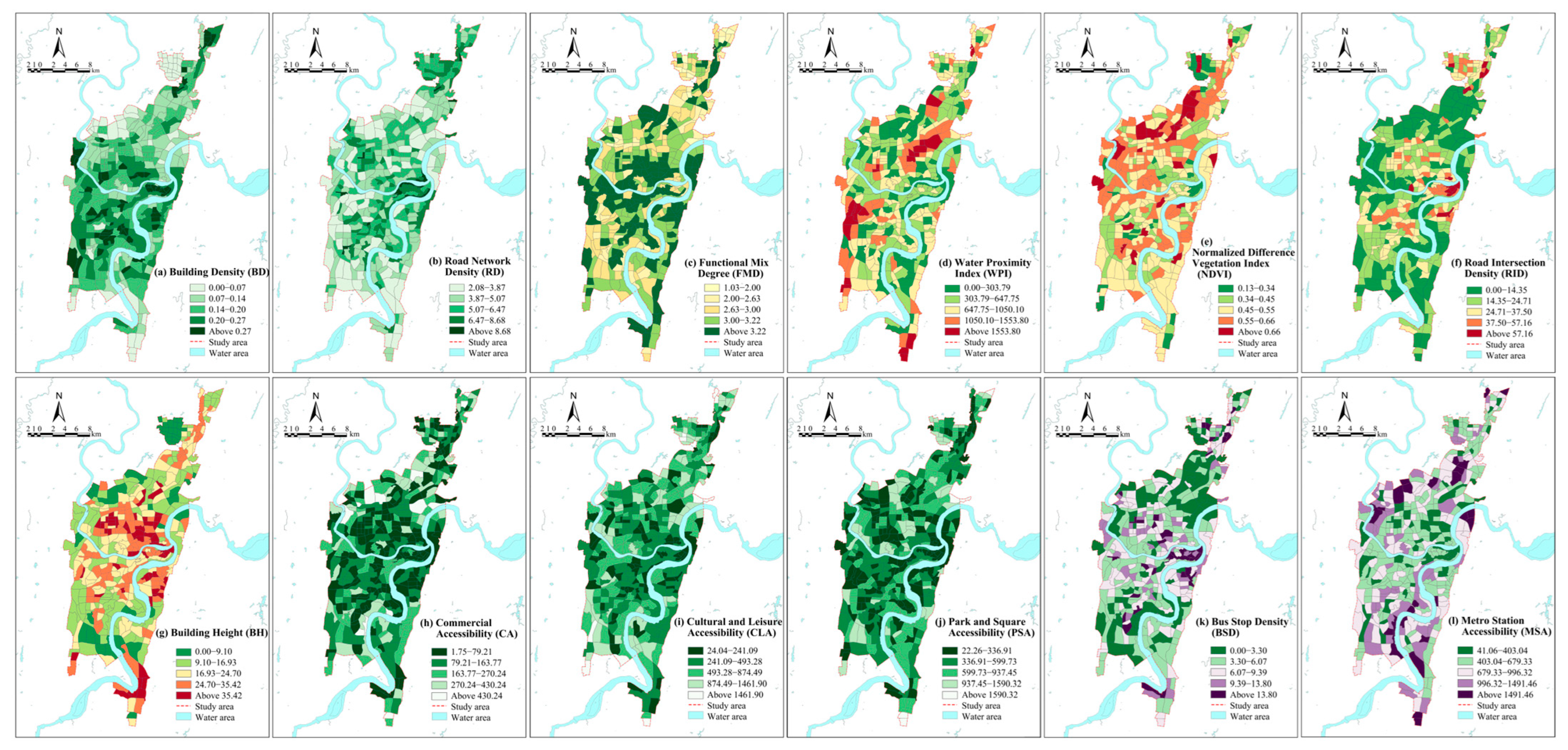
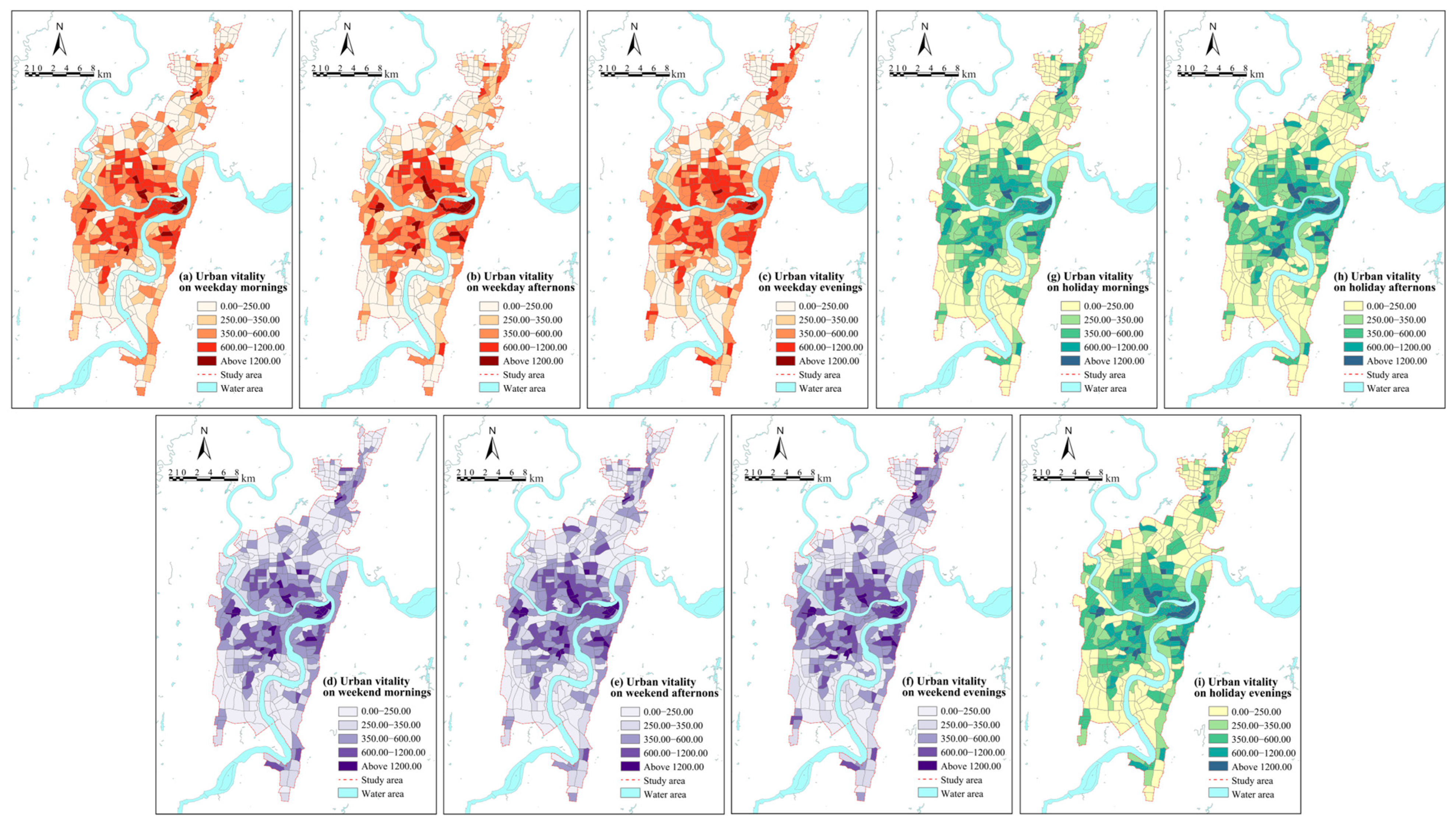

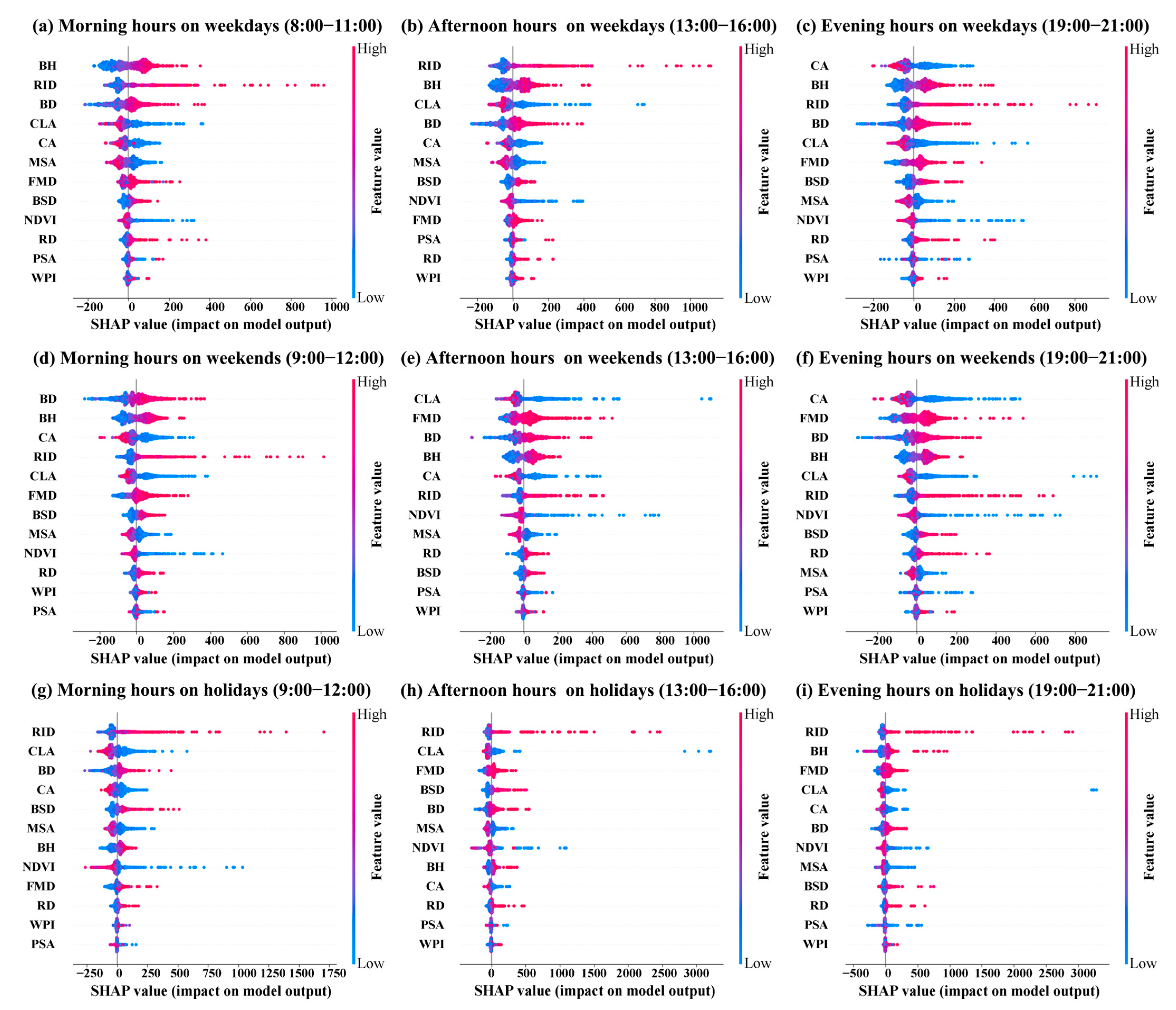

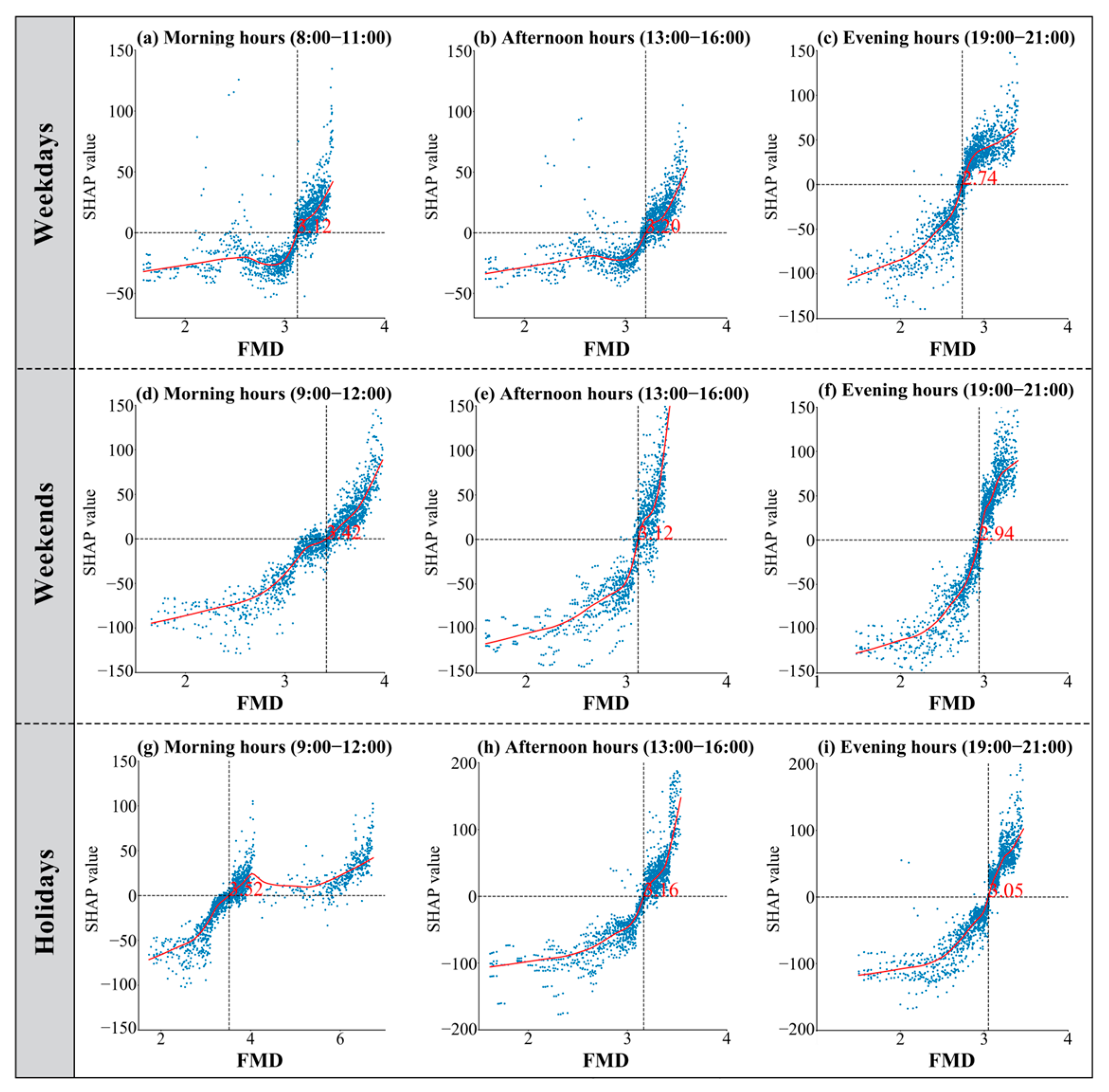
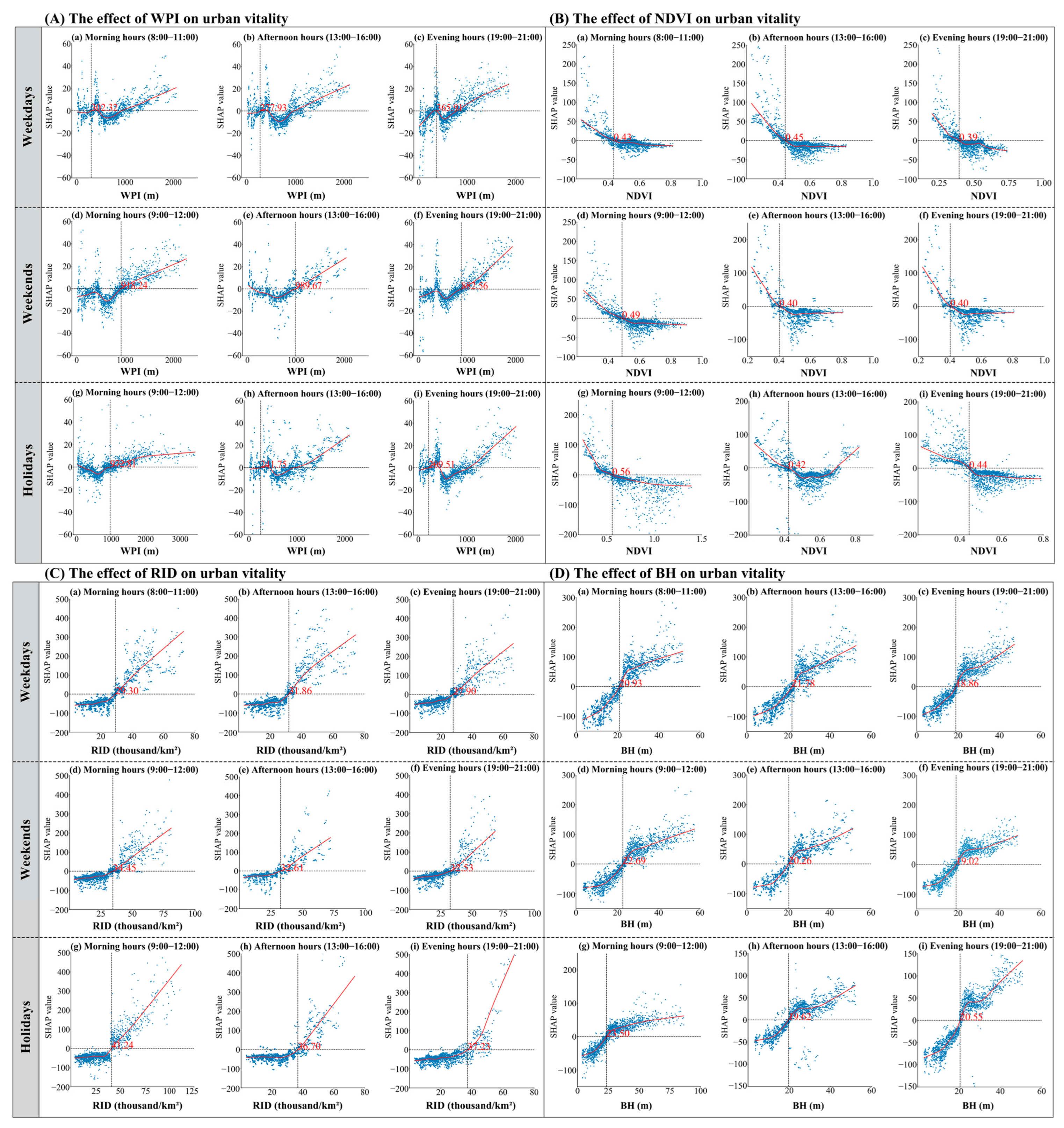
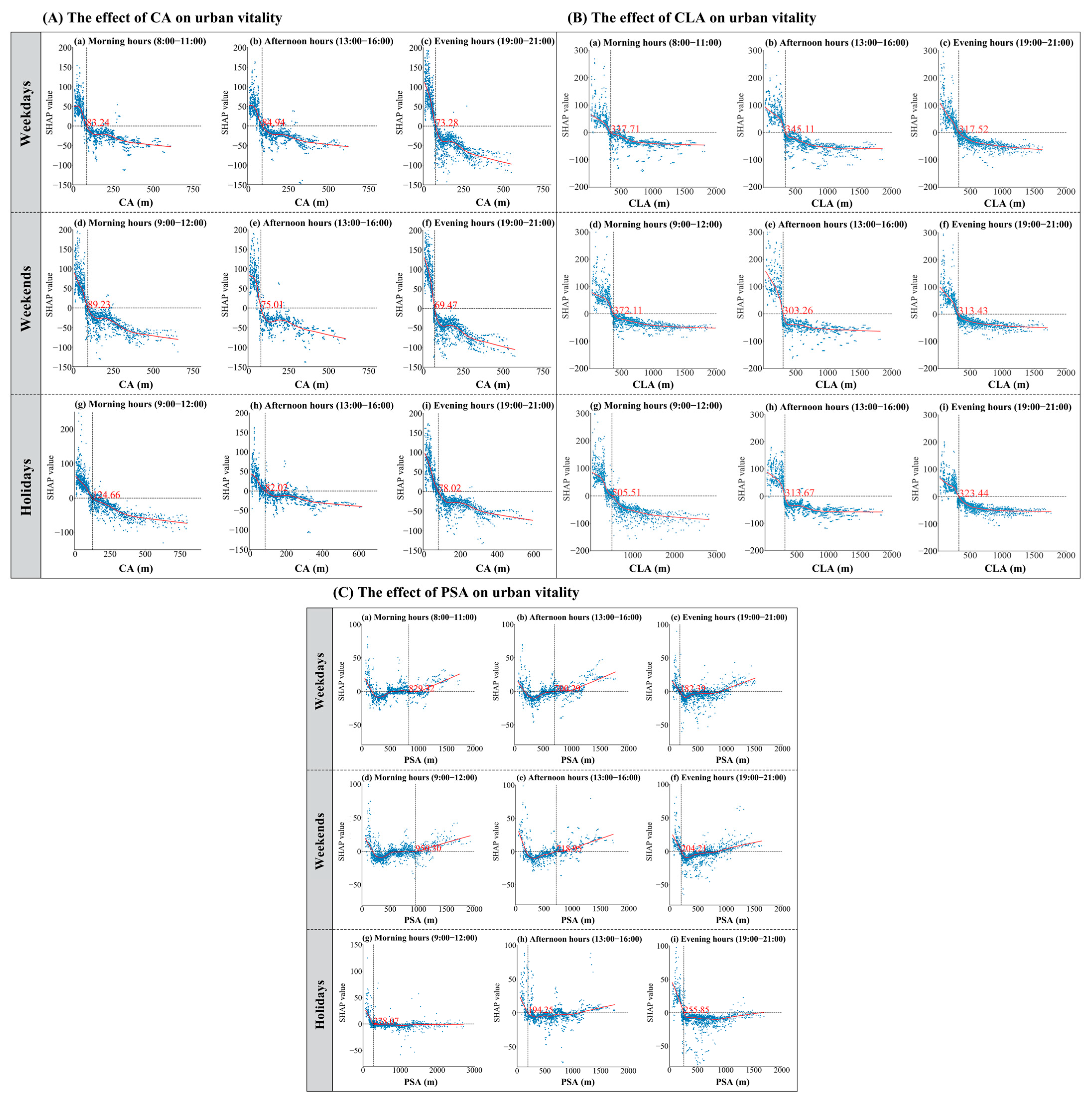

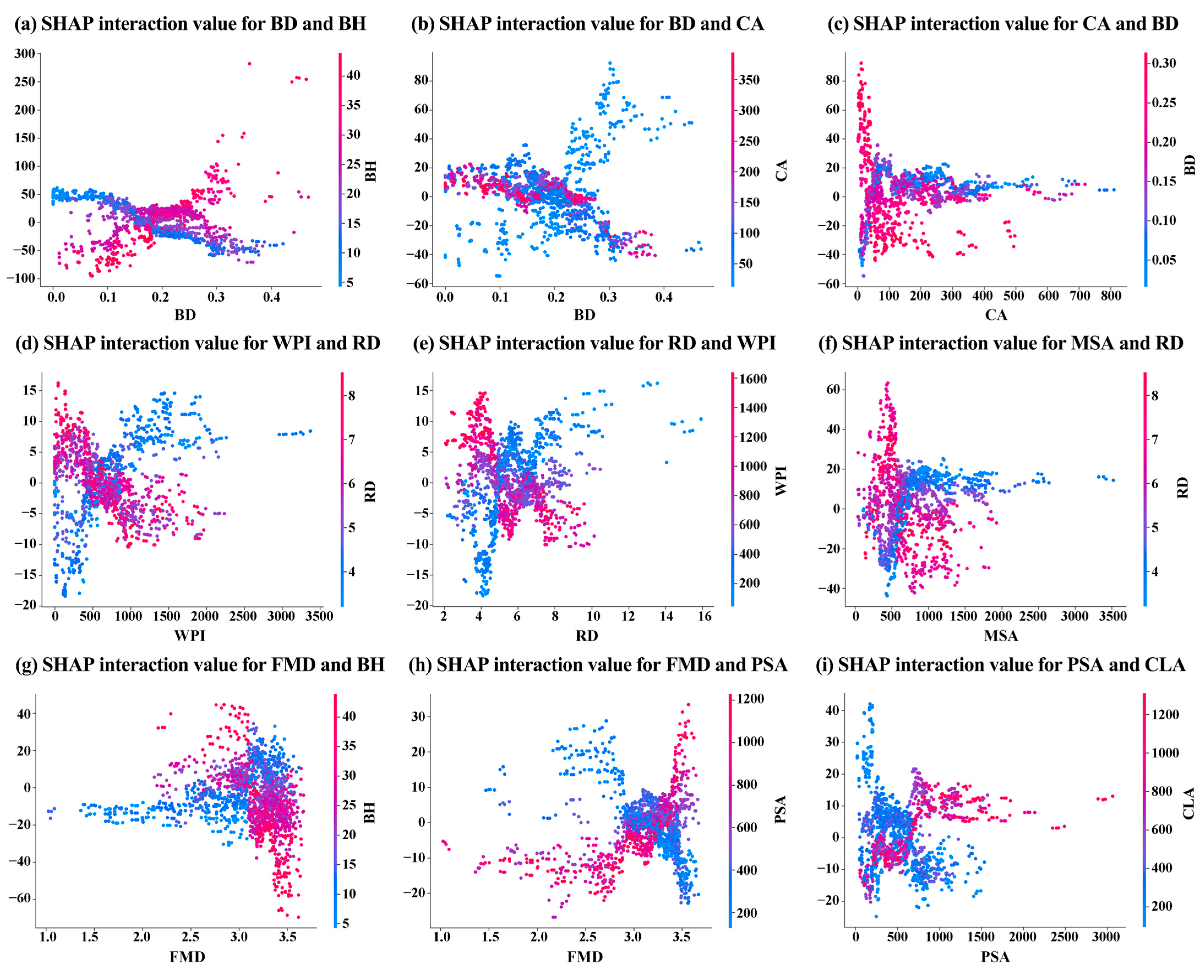
| Date Type | Morning Hours | Afternoon Hours | Evening Hours |
|---|---|---|---|
| Weekdays | 8:00–11:00 | 13:00–16:00 | 18:00–21:00 |
| Weekends | 9:00–12:00 | 13:00–16:00 | 18:00–21:00 |
| Holidays | 9:00–12:00 | 13:00–16:00 | 18:00–21:00 |
| Dimension | Indicator | Abbr. | Description | Data Source |
|---|---|---|---|---|
| Density | Building Density | BD | Building footprint area/block area | Gaode Map. |
| Road Network Density(km/km2) | RD | Total road length inside the block (outward-facing roads)/block area | OSM data. | |
| Diversity | Functional Mix Degree | FMD | Diversity index of various POIs within the block (calculated using Shannon’s diversity index) | Gaode Map. |
| Design | Water Proximity Index (m) | WPI | Distance from block centroid to nearest water body | OSM data. |
| Normalized Difference Vegetation Index | NDVI | Average fractional vegetation cover within the block | Gisrs. | |
| Road Intersection Density (thousand/km2) | RID | Number of road intersections/block area | OSM data. | |
| Building Height (m) | BH | Average building height within the block | Gaode Map. | |
| Destination Accessibility | Commercial Accessibility (m) | CA | Distance from block centroid to nearest commercial POI | Gaode Map. |
| Cultural and Leisure Accessibility (m) | CLA | Distance from block centroid to nearest cultural and leisure POI | Gaode Map. | |
| Park and Square Accessibility (m) | PSA | Distance from block centroid to nearest park or square | Gaode Map. | |
| Distance to transition | Bus Stop Density (thousand/km2) | BSD | Number of bus stops inside the block/block area | Gaode Map. |
| Metro Station Accessibility (m) | MSA | Distance from block centroid to nearest metro station | Gaode Map. |
| Indicator | Nonlinear Threshold | Impact Direction | Mountain City Characteristics |
|---|---|---|---|
| BD | 0.22 | First negative and then positive | Terrain limits space compactness, moderate density promotes vitality |
| RD | 6.39 km/km2 | First negative and then positive | Dispersed road network requires higher density for accessibility |
| FMD | 3.00 | First negative and then positive | Functional diversity promotes vitality, adapts to complex terrain |
| WPI | 277.93 m, 400.00 m, 1000.00 m | First negative and then positive and then negative and then positive | Water distribution is limited by terrain; restricted space utilization affects vitality |
| NDVI | 0.39 | First positive and then negative | Excessive greening leads to spatial isolation, reducing social density |
| RID | 41.24 per/km2 | First negative and then positive | Dispersed road network, high-density intersections promote traffic connectivity and vitality |
| BH | 23.50 m | First negative and then positive | Large terrain elevation difference, higher buildings improve spatial perception, but excessive height may cause spatial congestion; moderate increase promotes vitality |
| CA | 69.47 m | First positive and then negative | Due to complex terrain, the influence of commercial areas is limited; too distant commercial areas no longer attract people, leading to decreased vitality |
| CLA | 303.26 m | First positive and then negative | Due to complex terrain, the influence of cultural and recreational areas is limited; too distant areas no longer attract people, leading to decreased vitality |
| PSA | 182.39 m, 950.30 m | First positive and then negative, then positive | Greening concentrated in mountains and slopes, nearby parks have strong attraction, but at greater distances, the attraction gradually decreases due to terrain limitations |
| BSD | 6.15 per/km2 | First negative, then positive | When the traffic network density is low in mountainous cities, vitality is limited; as density increases, traffic improves, and vitality increases |
| MSA | 618.19 m | First positive, then negative | When metro stations are far, commuting is difficult, and vitality is lower |
Disclaimer/Publisher’s Note: The statements, opinions and data contained in all publications are solely those of the individual author(s) and contributor(s) and not of MDPI and/or the editor(s). MDPI and/or the editor(s) disclaim responsibility for any injury to people or property resulting from any ideas, methods, instructions or products referred to in the content. |
© 2025 by the authors. Published by MDPI on behalf of the International Society for Photogrammetry and Remote Sensing. Licensee MDPI, Basel, Switzerland. This article is an open access article distributed under the terms and conditions of the Creative Commons Attribution (CC BY) license (https://creativecommons.org/licenses/by/4.0/).
Share and Cite
Yang, J.; Wang, E. Exploring the Nonlinear Impacts of Built Environment on Urban Vitality from a Spatiotemporal Perspective at the Block Scale in Chongqing. ISPRS Int. J. Geo-Inf. 2025, 14, 225. https://doi.org/10.3390/ijgi14060225
Yang J, Wang E. Exploring the Nonlinear Impacts of Built Environment on Urban Vitality from a Spatiotemporal Perspective at the Block Scale in Chongqing. ISPRS International Journal of Geo-Information. 2025; 14(6):225. https://doi.org/10.3390/ijgi14060225
Chicago/Turabian StyleYang, Jiayu, and Enxu Wang. 2025. "Exploring the Nonlinear Impacts of Built Environment on Urban Vitality from a Spatiotemporal Perspective at the Block Scale in Chongqing" ISPRS International Journal of Geo-Information 14, no. 6: 225. https://doi.org/10.3390/ijgi14060225
APA StyleYang, J., & Wang, E. (2025). Exploring the Nonlinear Impacts of Built Environment on Urban Vitality from a Spatiotemporal Perspective at the Block Scale in Chongqing. ISPRS International Journal of Geo-Information, 14(6), 225. https://doi.org/10.3390/ijgi14060225











